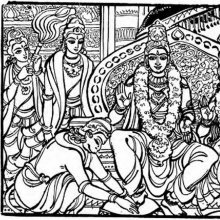Sang: 3 definitions
Introduction:
Sang means something in the history of ancient India, Hindi, biology. If you want to know the exact meaning, history, etymology or English translation of this term then check out the descriptions on this page. Add your comment or reference to a book if you want to contribute to this summary article.
Images (photo gallery)
India history and geography
Source: Mandala Texts: Yakchoe: The Grand Festival of Ura VillageSang is the name of a ceremony practiced in the village Ura Makrong in Bhutan.—The Yakchoe is one of over a dozen festive events in Ura’s annual ritual calendar. The Ura Guru Lhakhang is the venue for most of these scheduled events including the nyuney ritual in the first month, reading of the Kanjur in the second month, zhingdrub ceremony in the fourth, sang in the seventh, drubchen in the eighth and gonpo ritual in the ninth month. Other religious events and funerary ceremonies also take place in the temple.

The history of India traces the identification of countries, villages, towns and other regions of India, as well as mythology, zoology, royal dynasties, rulers, tribes, local festivities and traditions and regional languages. Ancient India enjoyed religious freedom and encourages the path of Dharma, a concept common to Buddhism, Hinduism, and Jainism.
Biology (plants and animals)
Source: Wisdom Library: Local Names of Plants and DrugsSang in the Mizo language is the name of a plant identified with Stemona tuberosa Lour. from the Stemonaceae (Stemona) family. For the possible medicinal usage of sang, you can check this page for potential sources and references, although be aware that any some or none of the side-effects may not be mentioned here, wether they be harmful or beneficial to health.

This sections includes definitions from the five kingdoms of living things: Animals, Plants, Fungi, Protists and Monera. It will include both the official binomial nomenclature (scientific names usually in Latin) as well as regional spellings and variants.
Languages of India and abroad
Hindi dictionary
Source: DDSA: A practical Hindi-English dictionary1) Sang in Hindi refers in English to:—(nm) company, association, contact; attachment; stone; (ind) with, along with; ~[ja] born through contact; ~[dila] stone-hearted, cruel; ~[dili] stone heartedness, cruelty; ~[maramara] marble; ~[maramari] white and gracious like marble; ~[rodha] quarantine; —[sona] to go to bed (with)..—sang (संग) is alternatively transliterated as Saṃga.
2) Sang in Hindi refers in English to:—(nf) a heavy iron implement for digging up a well..—sang (सांग) is alternatively transliterated as Sāṃga.
3) Sang in Hindi refers in English to:—(a) having limbs or body, together with the body; complete, entire; organic; —[rupaka] sustained metaphor..—sang (सांग) is alternatively transliterated as Sāṃga.
...
See also (Relevant definitions)
Starts with (+810): Can-mukamuttirai, Canka-mataipalli, Canka-viyattukkupar, Cankacam, Cankaikketu, Cankaiman, Cankaivan, Cankaiyinam, Cankakkappu, Cankakkulaiyan, Cankalai, Cankalaikkinaru, Cankalam, Cankalanam, Cankalar, Cankalekai, Cankalikan, Cankalikitam, Cankaloshtam, Cankamalinkam.
Ends with (+57): Adi-marsang, Akshosang, An kisang, Ansang, Ara songsang, Asang, Asisang, Bei e hai sang, Bonjangsang, Bosisang, Chi sang, Cu sang, Dadap lesang, Dieng jarasang, Dieng-soh-sang, Ensesang, Enzesang, Esang, Esisang, Essang.
Full-text (+253): Sang seng, Sang kae, Sang ke, Than-sang, Nai sang, Cu sang, Sang bai pi, Phai sang, Sang-kuppi, Hai sang, Sang-sanga, Sang ye, Sang ji sheng, Pai sang, Ma sang, Gayi, Ji sang, Hei sang, Chi sang, Lu sang.
Relevant text
Search found 137 books and stories containing Sang; (plurals include: Sangs). You can also click to the full overview containing English textual excerpts. Below are direct links for the most relevant articles:
Blue Annals (deb-ther sngon-po) (by George N. Roerich)
Chapter 9 - The Chapter on Rgya ma pa < [Book 5 - The Sovereign Lord (Atiśa)]
Chapter 13 - Staglungpa (viii): Ratna guru < [Book 8 - The famous Dakpo Kagyü (traditions)]
Chapter 8 - The Chapter on the disciples Bya yul pa < [Book 5 - The Sovereign Lord (Atiśa)]
The Great Chariot (by Longchenpa)
Part 3b - The kaya of the manifestation of enlightenment < [B. The explanation of the kayas and wisdoms]
Part 1b.1e - What predominates in the three chief realms < [B. The extensive explanation of the nature of karma]
Tibet (Myth, Religion and History) (by Tsewang Gyalpo Arya)
4. How Bon spread to Tibet < [Chapter 6 - Tonpa Shenrab Mibo and Bon Religion]
9. Conclusion < [Chapter 1 - Early Tibetan Origin Myth]
9. Zhangzhung sMar yig as the Source < [Chapter 5 - Tibetan Language and Writing System]
Guhyagarbha Tantra (with Commentary) (by Gyurme Dorje)
Text 12.14 (Commentary) < [Chapter 12 (Text and Commentary)]
Text 2.2 (Commentary) < [Chapter 2 (text and commentary)]
Text 2.14 (Commentary) < [Chapter 2 (text and commentary)]
Bodhisattvacharyavatara (by Andreas Kretschmar)
Khenpo Kunpal's Commentary (tibetan)
Text Section 44 < [Khenpo Chöga’s Oral Explanations]
Text Section 247 < [Khenpo Chöga’s Oral Explanations]
Satapatha-brahmana (by Julius Eggeling)
Kāṇḍa VIII, adhyāya 4, brāhmaṇa 3 < [Eight Kāṇḍa]
Kāṇḍa VI, adhyāya 1, brāhmaṇa 1 < [Sixth Kāṇḍa]
Kāṇḍa XIII, adhyāya 7, brāhmaṇa 1 < [Thirteenth Kāṇḍa]
